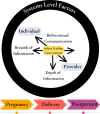What is effective communication in breastfeeding care? Perspectives from Latina women
- PMID: 40569968
- PMCID: PMC12200710
- DOI: 10.1371/journal.pone.0325592
What is effective communication in breastfeeding care? Perspectives from Latina women
Abstract
Background: Despite effective communication being critical to providing person-centered care, little is known of effective communication in breastfeeding care from the perspective of Latina women in the United States (U.S.) who experience breastfeeding inequities. Our study identifies (a) what constitutes effective communication and (b) which provider practices promote or hinder effective communication in the context of breastfeeding care delivered within the pregnancy, delivery, and postpartum periods to Latina women in the U.S.
Methods: We analyzed data from a community-engaged study that included semi-structured interviews in English or Spanish with Latina women from low-income households in Connecticut. Women were asked about communication experiences with healthcare providers during their breastfeeding care across the pregnancy, delivery, and postpartum periods. Reflexive thematic analysis was used to analyze the data and develop a framework depicting key themes.
Results: Of the 21 women interviewed, approximately half were 25-31 years of age (48%), were born outside of the U.S. (52%), and most had prior children (86%). We identified two themes of what constitutes effective communication in breastfeeding care to Latina women: personalized breadth and depth of breastfeeding information (theme 1) and bidirectional exchange of information with providers (theme 2). Provider use of open-ended questions that explored women's breastfeeding experiences, goals, and challenges asked across the breastfeeding care continuum promoted effective communication. Conversely, providers who asked about breastfeeding at a single visit and/or used rushed, checklist-style questioning left women with unmet information needs and hindered effective communication. While some women preferred communication aligned with their cultural and language preferences, others appreciated providers who engaged with non-fluent Spanish, seen as a supportive gesture. Our "Framework for Effective Communication in Breastfeeding Care" illustrates our findings.
Conclusion: Our findings could inform provider and systems level efforts to promote more effective communication in breastfeeding care, ultimately enhancing care quality and person-centeredness.
Copyright: © 2025 Nardella et al. This is an open access article distributed under the terms of the Creative Commons Attribution License, which permits unrestricted use, distribution, and reproduction in any medium, provided the original author and source are credited.
Conflict of interest statement
The authors have declared that no competing interests exist.
Figures

Similar articles
-
Perceptions and experiences of the prevention, detection, and management of postpartum haemorrhage: a qualitative evidence synthesis.Cochrane Database Syst Rev. 2023 Nov 27;11(11):CD013795. doi: 10.1002/14651858.CD013795.pub2. Cochrane Database Syst Rev. 2023. PMID: 38009552 Free PMC article.
-
"It's a tool, it's got hardships": a qualitative study of patient experience of colonoscopy and implications for trauma-informed care.Therap Adv Gastroenterol. 2025 Jun 21;18:17562848251346250. doi: 10.1177/17562848251346250. eCollection 2025. Therap Adv Gastroenterol. 2025. PMID: 40547252 Free PMC article.
-
Maternal and neonatal outcomes of elective induction of labor.Evid Rep Technol Assess (Full Rep). 2009 Mar;(176):1-257. Evid Rep Technol Assess (Full Rep). 2009. PMID: 19408970 Free PMC article.
-
Parents' and informal caregivers' views and experiences of communication about routine childhood vaccination: a synthesis of qualitative evidence.Cochrane Database Syst Rev. 2017 Feb 7;2(2):CD011787. doi: 10.1002/14651858.CD011787.pub2. Cochrane Database Syst Rev. 2017. PMID: 28169420 Free PMC article.
-
Factors that influence parents' and informal caregivers' views and practices regarding routine childhood vaccination: a qualitative evidence synthesis.Cochrane Database Syst Rev. 2021 Oct 27;10(10):CD013265. doi: 10.1002/14651858.CD013265.pub2. Cochrane Database Syst Rev. 2021. PMID: 34706066 Free PMC article.
References
MeSH terms
Grants and funding
LinkOut - more resources
Full Text Sources
Medical

